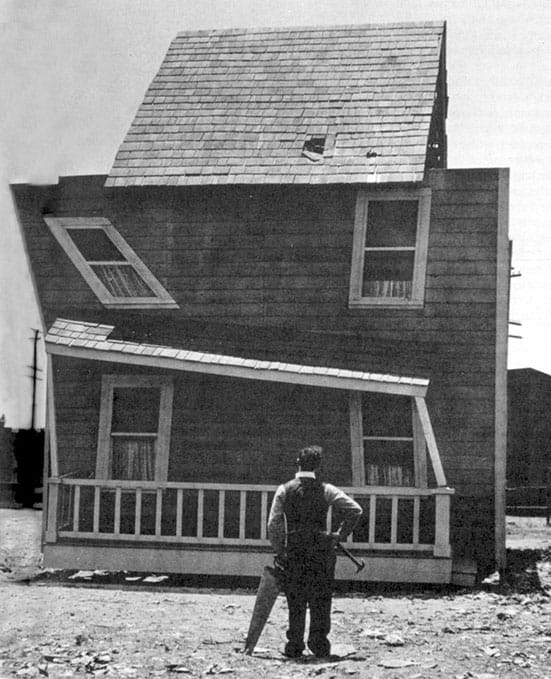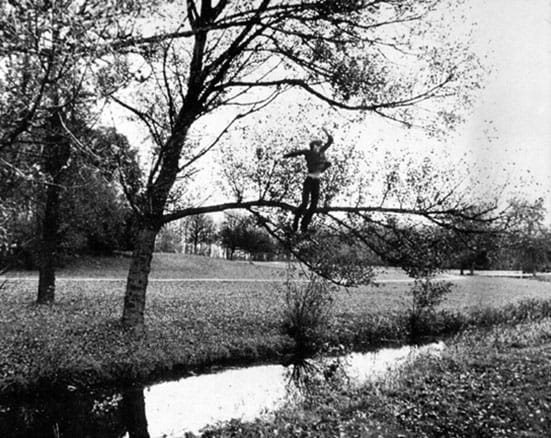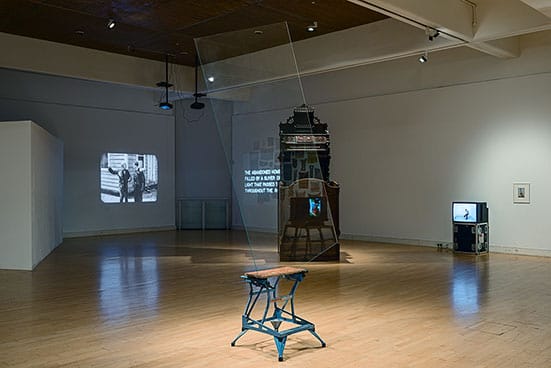Buster Keaton was one of the most schematic and precise artists of cinema's early years. His control was evident both physically and emotionally and, whilst he is commonly remembered as a slapstick aficionado, in fact his work was emotionally and comically broad-ranging – at times melancholic, absurd, full of failure, bathetic, anarchic, dry, conceptual and brutal.
The World Turned Upside Down – Buster Keaton, Sculpture and the Absurd, co-curated by Ben Roberts and the artist Simon Faithfull, to much acclaim, juxtaposed Keaton's early film with that of twenty-five contemporary artists, whose work inhabits the sensibility and ability of Keaton to interact and manipulate with objects.
Anchoring the exhibition were three pairings of a Keaton film and an artist’s film. One Week, in which Keaton and his new wife attempt to construct a flat-pack house with disastrous results (this short film is the one that contains the infamous wall-falling scene, where Keaton is saved from certain doom by a well-placed window) is juxtaposed with Gordon Matta-Clark’s seminal Splitting, in which he carefully bisects a house in New Jersey in 1974. Fischli & Weiss’s alchemic The Way Things Go is mirrored by The Boat and The Cameraman with Bas Jan Ader’s Broken Fall (Organic), Amsterderdamse Bos, Holland, in which the artist hangs by his hands from a tree branch over a river until his strength gives out and he inexorably falls in.
Elsewhere, the sculptural presence of the exhibition was developed through a narrative of absurd event, physical presence and danger and transformation – Ben Woodeson’s Fuck You You Fucking Fuck, with its large pane of glass, precariously clamped upright into a workbench; Ruth Proctor’s Ok, Set, Drop whereby the artist falls backwards from a scaffold tower. Whereas in a film the boxes would be hidden from view, here the gag is explained by the boxes’ sculptural presence in the space, and the use of the scaffold tower to display the monitor on which the action can be seen after the live event; in Emma Hart’s LOST a new wall has been created a foot from the original gallery wall, forcing the audience to view the work in the tight space between. LOST features a hand-held camera searching the dusty crevices under a bed, revealing a hidden world of objects lost and found alongside the artists excitable commentary.
I met with curator Ben Roberts to talk about the impetus for the exhibition and the curatorial challenges of putting it together.
Can you tell me where the initial inspiration for the exhibition came from?
The exhibition came out of a discussion between myself and Simon Faithfull when we had been talking about his work O Degrees Navigation in which he walks across the UK from coast to coast following the Greenwich meridian. In some ways the work is a kind of homage to Buster Keaton, in particular his work with Canadian film maker Gerald Potteron on the film Railroader. In that film you see Keaton on Westminster Bridge looking at a map of Canada, he looks up, sees he’s in the wrong place and jumps off the bridge, to emerge in the next shot from the sea on the Canadian coast. He then travels in a line of continuous movement across the continent. Discussing these two works and their relationship we began to consider Keaton’s wider body of work and in particular the short films he made in the 1920s before signing with MGM. It was at this time that he had an unprecedented freedom for a director/filmmaker – effectively running a studio within a studio with his own team of technicians, engineers, cameramen etc.
Can you tell us about how you began to make the selection for the exhibition - and also about what you left out in terms of works that directly referenced Keaton’s work. (I’m thinking particularly of Steve McQueen's Deadpan which remakes a scene from Steamboat Bill).
Thinking about Keaton’s early films immediately bought to mind some of the key artists in the show – Gordon Matta-Clark, Fischli and Weiss, Bas Jan Ader – and we began to feel that perhaps there was something wider about Keaton’s approach to film making in terms of his approach to risk, failure, objects and materials, entropy which resonated with a great deal of modern and contemporary art practices.
The exhibition grew from there, but I wouldn’t say the idea was to suggest that the art works we choose take Keaton as a starting point; rather that it was about reconsidering them in the light of Keaton's’ work.
The suggestion is not that Keaton was the grandfather of contemporary conceptual art practice but that his approach to making his own work has a legacy which runs through contemporary art (perhaps more so than cinema) – so this exhibition was a way of both reconsidering some well-known art works and also reappraising Keaton’s output as well. It was really when we began thinking about the younger and contemporary artists in the show that it became apparent that some of these ideas were bigger than both Keaton or any particular artwork.
That’s really why, there are some apparent omissions – the Steve McQueen is of course one, but we felt that it was of a different order. That piece is more of a quotation from Keaton than a manifestation of an independent practice, shot through with a Keatonesque sensibility, and so for that reason we decided not to pursue it. There are other works we would dearly love to have included – Simon Starling’s Autoxylopyrocycloboros being the most prominent as well as some Francis Alys’ films but their installation costs made it prohibitive.
Some of the curatorial decisions that you made - particularly incorporating Keaton’s work into the exhibition and juxtaposing certain works very specifically (as described about with for example, One Week and Splitting or The Boat and The Way Things Go). Why did you think it was important that these works were re-appraised? What particular elements of Keaton's work do you think are most interesting in relation to contemporary practice?
The idea to have the Keaton films paired with the artists’ works was the concept we built the show around from the very beginning – suggesting an explicit connection between Keaton’s work and visual art practices, in particular sculpture. Many of the works that we chose for the show are, of course, either well know, at least to an art audience, and/or by well known artists and so curatorially the show as never going to stand on novelty, which is to say discovering new artists. The idea was very much more to suggest a new reading of works which have already been very widely discussed and to that end we felt it was important to have Keaton as a strong presence to make the point. Rather than closing down readings of the works the hope was that by bringing all these things together with Keaton out in the open as it were it might in fact offer new insights by shifting the familiar frame of reference.
The interaction with, and use of, objects is a very important part of the show and a crucial part of the relationship between Keaton and modern and contemporary art. But just as important were a raft of other areas such as risk, melancholy, theatricality, failure and humour. What I think is interesting is that many of these things haven’t been especially fashionable in contemporary art – humour, text-less performance and stage craft are still looked down on in many ways. But the argument that we are making is that this process and way of making is more nuanced that being just about slapstick, for example. So many of these artists’ practices, from Roman Signer to Ruth Proctor, contain elements of all these things. For me, the most interesting thing which runs through all this is the relationship between the performance and the object; making through doing, failing, doing it again to paraphrase Beckett. There is a delight in the absurdity in the world and the fun which can be had with it which I think is both very profound and extremely engaging. Crucially it also takes a great deal of skill, control and experience.
You mention being interested in the ‘relationship between the performance and the object’ but I wonder if such a distinction is made in the exhibition?
I think this all comes down to ideas of transformation – of the object, of the performer, of the idea in the mind of the viewer and to a certain extent how characters and relationships are transformed within the internal logic of a piece. One of the things that has always fascinated me about Keaton is the way in which objects in his films (boats, ladders, bananas etc) are transformed through his interaction with them, in particular Keaton's insistence on treating objects according to their physical properties rather than prescribed ideas about what an object’s function is, so a banana becomes a gun, a ladder becomes a seesaw and a boat bears no relation to its surroundings because all these things can and do stand in for each other and there’s really no reason why they shouldn’t. On the most basic level this way of a approaching the world is fundamental to the process of making art but the relationship with performance comes through animation. Objects themselves can be performative (a can of paint knocking into some tyres) just as an action can have sculptural quality (a man falling from a tree) because they describe the physical world around us using that physicality, however in both cases there is a delight in the ephemeral nature of that physical animation and that is the meeting point between the two. It’s right to question if a distinction is made between performance and object within this show but I think it rather suggests that they are two sides of the same coin.
Keaton's childhood was spent being quite literally thrown around the stage as an object as part of his parents Vaudeville act and I wonder if the body becomes object in his work?
I do not think that I would go so far as to say that the body becomes an object for Keaton because crucially all his work and, in fact, the work in the show is deeply rooted in a logical and physical reality in which a body remains a human body and a fence a fence. It just that a body can dive through a fence because it’s agile enough to use it as a trap door.
In that context, Keaton’s upbringing in vaudeville is important because it gave him a profound understanding of how the body can behave in space and what its physical limits are. However for Keaton it’s vital that he as a person and a character remain at the centre with the world collapsing and reforming around him to his own perpetual confusion and befuddlement. Much of the work in the show is concerned with this instability in our knowledge and experience of the world whether it’s an attempt to impose order (Tehching Hsieh), deliberately de-stabilising (Gordon Matta-Clark) or embracing the absurdity (William Wegman).
Can you talk about you dealt with the relationship between the live and recorded elements of the exhibition – what, curatorially are the challenges of such a mix? Did you worry about how an audiences approaches works that need to be activated, or the detritus from performances that they haven’t seen?
If you consider this relationship between the performance and the object, the live and the recorded, as being part of the same thing then, conceptually, many of the issues around their presentation as one or the other fall away because then a preference for live or film is just a fetish. Where an important distinction needs to be made though, is the difference between the performance as sculpture and its detritus which is not the same thing. Angus Braithewaite’s work Objects Falling on the Artists’ Head I think works in this regard because although it is detritus, the title means it also explicitly animates the objects in the viewer’s head. Erwin Wurm’s One Minute Sculpture is another case in which the object is animated by the performer but without which they remain what they are. Crucially, I think that when presenting works in this way the acid test is whether they stand up in their own right in the space – as artworks. Activation by an audience is often a difficult thing to achieve in terms of showing people that it is ok to do something and breaking down the barriers between viewer and art work. However, this is, I think a more technical issue and not necessarily something that should prevent a work from being included, but it is certainly something which needs to be considered. The difficulty really is in trying to ensure that the work can retain its integrity while at the same time being accessible.
Rose Lejeune

Buster Keaton One Week 1920

Bas Jan Ader Broken fall (Organic) 1971

Buster Keaton The Cameraman 1928

Installation View: The World Turned Upside Down – Buster Keaton, Sculpture and the Absurd
Mead Gallery, Warwick Art Centre, 4 October – 14 December 2013.

Installation View: The World Turned Upside Down – Buster Keaton, Sculpture and the Absurd
Mead Gallery, Warwick Art Centre, 4 October – 14 December 2013.